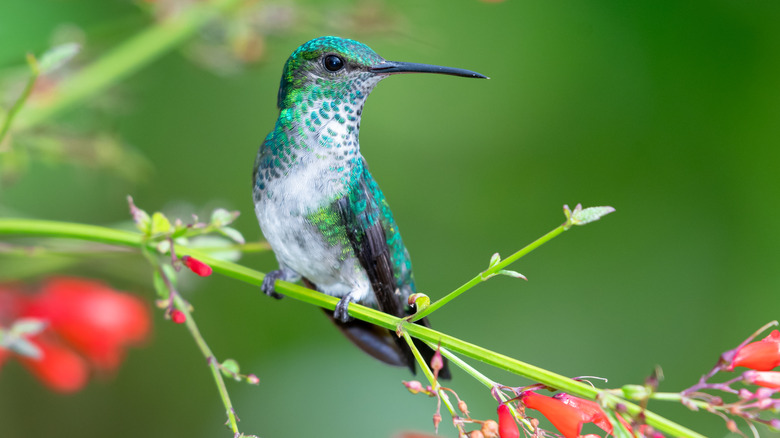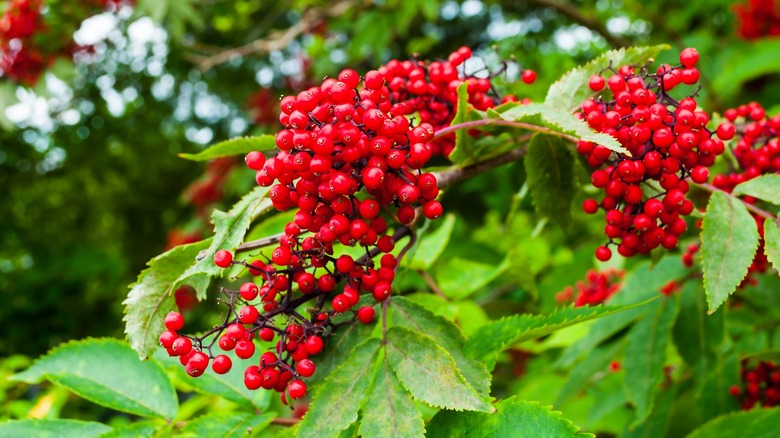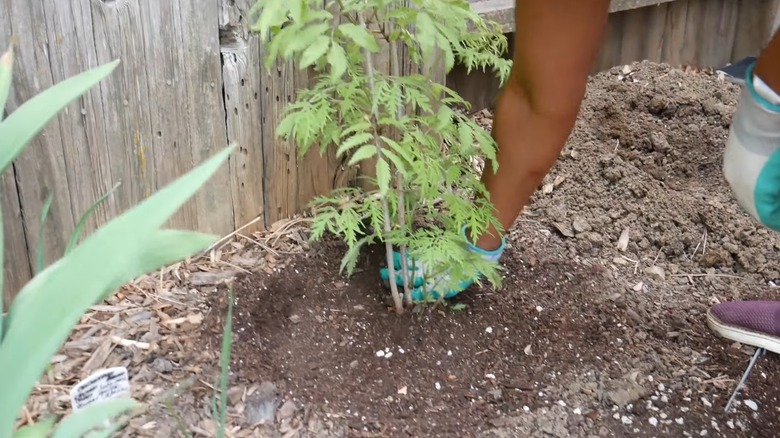Hummingbirds Will Keep Returning To Your Yard For This Tree's Show-Stopping Colors
With their sun-kissed iridescent feathers glinting like jewels as they pirouette from flower to flower, hummingbirds weave a trail of peerless magic in our yards. Unsurprisingly, sighting them, or even the possibility that they might stop by while migrating down south, has moved countless home gardeners to employ genius tips and tricks to attract more hummingbirds to their yards. For instance, putting up several sweet nectar-containing feeders, over 15 feet apart, to keep possessive hummers from indulging in territorial wars. Or, honeying the deal with better access to insects — either by enticing them with mature fruits or minimizing pesticide use — ripe for feeding their brood. However, another way to persuade hummingbirds to flock to your yard is to plant gorgeous trees they adore, such as the red elderberry tree (Sambucus racemosa subsp. pubens).
Winter hardy to USDA zones 3 to 7, scarlet elderberry trees (as they're known alternatively) are often planted to stabilize landscapes, given their tolerance of wet soils and contamination. They've also earned a reputation for being wildlife magnets, with over 23 bird species subsisting on their fruit and cover, although mammals like squirrels and bears race them for it. But what truly brings out their allure is how hummingbirds gravitate to their flowers when they're in full bloom from April to June.
Why do hummers make a beeline for red elderberry trees?
Supporting wings that audibly buzz over 80 times in a heartbeat of a second is hard work. For this reason, as well as to prepare themselves for the long migratory flight, hummers consume around twice their weight's worth of flower nectar, in addition to insects and critters. Luckily, red elderberry trees lay out the exact culinary spread that they desire, leaving them plenty of time to rest or mate. As the spring transitions into sunny summers, elderberry trees paint the landscape milky white with sap-rich, aromatic, dome-shaped flowers. These umbels bloom in successive flushes all summer long, grabbing the attention of famished hummingbirds who relish their carb-rich nectar.
Vivid red berries further make the scarlet trees attractive, as the aerial acrobats have exhibited a penchant for bright colors, including red and orange, in the past. Their 'Melanocarpa' variety is an exception since it grows purplish-black fruits. Moreover, as most hummingbird varieties settle down during June for nesting and incubating their eggs, the ready supply of aphids and spider mites — pests common to red elderberry trees — becomes valuable to assuage their and their fledglings' hunger. Hummingbirds may even pluck off spotted wing drosophila, an exotic insect notorious for damaging elder trees.
Growing red elderberry trees to encourage hummingbirds to return
As olfactory senses aren't hummers' strongest, they naturally veer toward places exhibiting the tastiest meal. In other words, they collect at spots with the biggest floral display, which can be achieved by planting red elderberry trees in groups. However, if space is premium, these native trees can grow almost 25 feet tall and wide, so plant them in pairs. This will aid cross-pollination, improving your crop. However, don't make the mistake of eating the berries without cooking them first; their toxic compounds like cyanogenic glycoside might not ruffle hummers' allegorical hair, but it won't be the same for you. Other plant parts, including foliage, stems, and flowers, are similarly poisonous for consumption, albeit sans the risk of contracting skin dermatitis.
Red elderberry shrubs are fast-growing trees that will thrive in damp soil, as their shallow roots can soak up any excess water. However, they're generally unfussy about their soils, including compaction. Site them in ample sun for the best performance, or at most in partial shade. Unfortunately, their high adaptability also makes them notorious spreaders, as they're quick to send out runners once established. While this wouldn't be an issue in an open habitat or if you were erecting a hedgerow, it makes them unsuitable around flower beds. But pruning their root suckers diligently every winter can stall their sprawl. Watch out for borers, powdery mildew, cankers, and leaf spot, and keep them shielded from sleet and gales.


